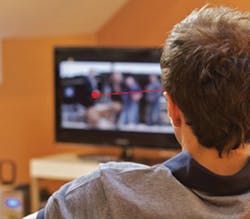As part of the new innovator area at the 2013 Digital Signage Expo, Kentan Banjara didn’t have a massive custom display at the show.
Banjara is vice president of business development and co-founder of Cube26, a California-based startup company and only had a single table at the show with a monitor, a camera and a couple of tablets to show his product. But when he picked up one tablet and showed people how he could start and stop a Rihanna video just by looking at the tablet, then control a video game character by moving his eyes, attendees would stop, look and listen to what his products can do.
“It will recognize your facial gestures or your facial expressions,” he said. “Like if you hold up your finger like it’s being shushed, it will quiet sound. It’ll recognize your face and it will say to itself ‘I know you, I’ve seen you before’ because it recognizes objects.”
As part of new changes at DSE, show organizers allotted space to smaller and startup companies this year as part of its "Innovator Zone" to allow smaller companies an opportunity to take part in the show and grow a client base in order to build up display area for future expos. Nearly 20 companies occupied the space.
Banjara said his company’s software not only recognizes when someone is looking at a screen, but also sends a custom advertisement to the person based on the data the software receives, such as age, gender or what they’re holding. He said the software can be trained to have it recognize whenever someone is looking at the digital screen holding a Starbucks coffee cup, and then send a custom ad based on that.
The applications can go far beyond custom advertisements, Banjara said, such as security, where the software can be trained to recognize movement as human or animal and what the human is that the camera spots.
The software also knows if you’re looking at it and if a camera is trained on a driver it can recognize if they’re not paying attention to the road and alert them to what’s happening or help stop the vehicle.
He said a railway company has even approached him and inquired about using the software to recognize if there are any issues with train cars.
“The intelligence in the system can be trained,” he said. “It can be trained to look at the [wheels] of the train to make sure they’re sitting well on the track or to make sure it’s being coupled well because it’s a visual detection system that can be trained for particular things to look for then trigger an alarm if they don’t see them.”
Lo-K Systems Inc. was in the zone as well and was displaying its recently unveiled Look System, which allows kiosks and digital signs to capture images of people who look at signs or advertisements in order to capture their gender and age.
Marty Paris, vice president of business development for Lo-K, said the ability to capture who is looking at the signs or advertisements gives advertisers or businesses the opportunity to see who is looking at the ads and at what times of day in order to focus who to pitch information to.
He said it also allows for research of digital sign advertisements to determine if they’re being placed in spots where they’re most effective.
“It allows them to intergrate,” he said.
Paris said the Look system also allows for the installation of more cameras to be installed in an area to track the people who look at digital signs and follow their movements and see if they engage in any other advertisements. The system could be connected with existing security cameras, but Paris said the recognition may not be as accurate.
There are some privacy issues the company is working through, Paris said, but the system currently keeps profiles on its cache for 15 minutes after engagement by the customer.
However, he said some customers are looking to store data much longer periods of time, which would allow advertisers or businesses to have rewards programs synched with smart phones, such as giving special sale prices to people who engage an ad, then go to the store later that day.
“It’s bigger than just one camera,” he said.
About the Author
Joe Petrie
Associate Editor
I came to Mass Transit in 2013 after spending seven years on the daily newsbeat in southeastern Wisconsin.
Based in Milwaukee, I worked as a daily newspaper reporter with the Waukesha Freeman from 2006-2011, where I covered education, county and state government. I went on to cover courts for Patch.com, where I was the main courts reporter in the Metro Milwaukee cluster of websites.
I’ve won multiple awards during the course of my career and have covered some of the biggest political events in the past decade and have appeared on national programs.
Having covered local government and social issues, I discovered the importance of transit and the impact it can have on communities when implemented, supported and funded.

